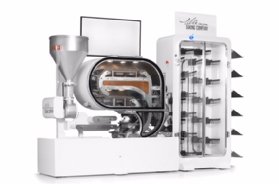
madgooch - stock.adobe.com
Business robotics moves off of the manufacturing floor
New uses of robotics are opening up in businesses, as applications for the technology begin to expand beyond its traditional place in manufacturing plants.
At this year's Think Big Festival, a symposium on robotics, it was clear that the focus of participants is on not pie-in-the-sky goals but on making real-world bread -- both literally and figuratively.
While robotics technology has been around since the 1950s, it mostly was used in large manufacturing plants until recently. The push on autonomous vehicles has helped changed that some, but self-driving cars are only one aspect of the emerging business robotics market. While they may seem to soak up all the investment capital and media buzz, there are many other potential uses of robotics in businesses and other organizations.
Even some drones could be considered robots. For example, xCraft is a company based in Coeur d'Alene, Idaho, that's working to develop more-autonomous drones to help first responders in emergency situations. The drones are being designed to get GPS coordinates from an emergency call center, fly to the scene of an incident, send a video report and then fly back to their bases for recharging.
Yet there is still much to be learned within technology and business circles about the applicability of robots in wider markets. The presenters at the Think Big Festival, which was held in Coeur d'Alene in late August, also showed the beginnings of that process. Let's look at two of the smaller companies that were at the event and what they're doing with business robotics.
Fresh baked bread without a baker
Making bread for retail is typically done in one of two ways. Your local baker gets up very early and risks repetitive stress injuries to knead dough and repeat other tasks in order to bake what the store thinks will be sold that day. Or a factory produces large volumes of bread that's packaged and sent to grocery stores via a long supply chain before it's finally put on the shelf.
Wilkinson Baking Company in Walla Walla, Wash., aims to solve a number of problems related to retail bread production with its Mini Bakery machine, which bakes bread without the help of human hands and is designed to be installed in grocery stores. The robotics-driven device is 10 feet wide by 2 feet deep and 6 feet high. That's small enough to fit into almost any store.

Nicknamed Breadbot, the Mini Bakery directly addresses the growing interest in both healthy eating and local sourcing; because the bread is made fresh in the store, no preservatives are needed and shipping costs are saved. And while it took a decade to develop the machine, early trials of it were successful, according to company founder and CEO Randall Wilkinson.
"Our previously unknown brand not only substantially increased bread sales in three test markets, but it also took a 30% to 50% market share in the stores," Wilkinson said in a presentation. He added that the Mini Bakery also lowered production costs, "resulting in lower prices for consumers and better profit margins for the grocery stores."
The attraction of the Mini Bakery is more than the pure business aspect. The robotic baking process is openly displayed, and the machine includes a touchscreen so customers can pick their own loaf from ones on display. There's also a vent to pipe the scent of the baking bread out of the display case.
The robotics are combined with a browser-based application that lets store managers set bread production to start before the store opens and then stop and restart it for peak shopping times. In addition, the application provides basic analytics on the machine's usage to help improve production planning. Future development plans include stronger analytics, Wilkinson said.
Creating a robotics ecosystem
While people brought up on the movie version of a robot might have problems understanding the Mini Bakery, there's no question that Misty Robotics Inc. builds what people imagine a robot to be. The Boulder, Colo., company's goal is to create a business robotics platform that can be extended by others to add features and capabilities to its Misty robots.

"Similar to the PC and smartphone markets, mass-market adoption of robotics will materialize when apps are built by developers that make them useful and productive," said Tim Enwall, who heads the company. Misty Robotics uses open source software and shares code for sample robotic skills with developers on GitHub. Its repository there includes modules for things such as movement, vision and armature.
The coding community can extend the codebase with components for specific business functions or actions. One example Enwall provided was to have a robot move through an office to take measurements and create 3D images for real estate listings. Another involved programming a robot to wander a concert hall and take recordings to check for dead spots and other sound issues.
Programmers are the company's primary audience. Its robots use Qualcomm processors, and developers are provided with a JavaScript RESTful API. That standardization means more people can quickly get up to speed, and no unique robotics-specific background is required to begin working on applications for the robots.
Business robotics for markets
The pun in the subhead above is intentional. Wilkinson Baking is looking at our grocery markets as an opportunity for robotics. Meanwhile, Misty Robotics aims to create a real-world market for robots that could become as ubiquitous as AI virtual assistants such as Amazon Alexa, Microsoft Cortana and Google Assistant.
Most people think of robotics in a few narrow areas, primarily in manufacturing. But the people who are interested in business robotics understand that it has a much wider potential, just as AI as a whole does. In fact, robotics, computer vision, machine learning and other technologies all started under the AI umbrella. Advances in hardware and software have helped each one individually, and we're starting to see that the reintegration of the technologies can lead to the development of real products.
The Think Big Festival is organized by the Innovation Collective, an organization based in Coeur d'Alene that helps entrepreneurs and startups build local support environments. The event showed that a lot of things are happening in robotics, often in places not thought of as high-tech centers. That's a clear indication the technology is maturing. So is the fact that business robotics applications are moving off of the manufacturing floor and into devices that can directly help companies and their customers.







